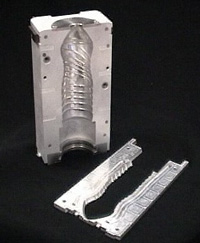The
most rapid RP systems are still too slow and are limited
as they can't produce parts in a wide range of materials,
at a fast enough rate, to perform the enormous range
of industry requirements. Despite the vast progress in
direct part fabrication, even conventional processes
such as molding and casting are still the only means
available.
RP is frequently the technological path making these manufacturing processes
faster, cheaper and better. Certainly, the tooling fabrication Is actually
the most important application of direct manufacturing.
The two main ways to make tooling molds using Rapid Prototyping are directly
fabricated by an RP system, or indirect or secondary processes RP-generated
parts that can be used as patterns for a mold fabricating.
 |
RT Process
Airway Cooling Vent |
|
